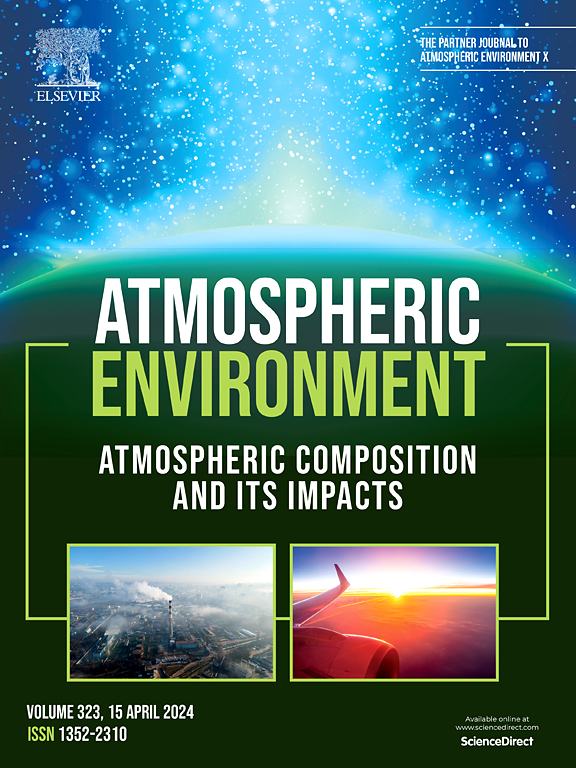Crucial VOCs influences on ozone formation in North China: A spatial perspective
IF 4.2
2区 环境科学与生态学
Q2 ENVIRONMENTAL SCIENCES
引用次数: 0
Abstract
With the increasing frequency of ozone (O3) pollution episodes in China, there is a growing emphasis on understanding the contributions of precursors to O3. Identifying key volatile organic compounds (VOCs) that drive O3 formation has become a primary research focus. However, comprehending these key VOCs' distribution characteristics and patterns remains challenging. This study employs the convergent cross-mapping (CCM) method to identify and quantify causal relationships between 25 VOCs and O3 simulated by WRF-Chem model. The results indicate that key VOCs identified by CCM can correspond well with those calculated based on observational data. Furthermore, the contributions and sources of various VOCs exhibits notable regional variations, showing a change with the O3 formation sensitivity (OFS). In areas where OFS is strongly limited by VOCs, such as coastal ports and cities with concentrated resources or populations, alkenes, ketoaldehyde, and alcohols contribute more to O3 formation. Meanwhile, the proportion of primary emission sources of oxygenated VOCs is relatively high (62.36–78.64 %), while secondary production sources are relatively low. Conversely, in regions where OFS is minimally limited by VOCs, such as agricultural areas in northern China, alkanes, aromatics, and phenols become more important. In this context, primary source contributions diminish while secondary source contributions rise to 19.1 %–45.6 %. Given North China's complex VOCs sources, this study suggests reducing key VOCs by targeting OFS characteristics within specific regions.

关键挥发性有机化合物对华北臭氧形成的影响:空间视角
随着中国臭氧(O3)污染事件频率的增加,人们越来越重视了解前体对O3的贡献。识别驱动O3形成的关键挥发性有机化合物(VOCs)已成为主要的研究重点。然而,了解这些关键挥发性有机化合物的分布特征和模式仍然具有挑战性。本研究采用收敛交叉映射(CCM)方法对WRF-Chem模型模拟的25种VOCs与O3之间的因果关系进行了识别和量化。结果表明,CCM识别的关键挥发性有机化合物与观测资料计算的关键挥发性有机化合物具有较好的对应关系。此外,各VOCs的贡献和来源表现出显著的区域差异,并随O3地层敏感性(OFS)的变化而变化。在VOCs严重限制OFS的地区,如沿海港口和资源或人口集中的城市,烯烃、酮醛和醇类对O3的形成贡献更大。同时,含氧VOCs一次排放源占比较高(62.36 - 78.64%),二次生产源占比较低。相反,在VOCs对OFS限制最小的地区,如中国北方的农业区,烷烃、芳烃和酚类变得更加重要。在这种情况下,主要来源的贡献减少,而次要来源的贡献上升到19.1% - 45.6%。鉴于华北地区VOCs来源复杂,本研究建议通过针对特定区域的OFS特征来减少关键VOCs。
本文章由计算机程序翻译,如有差异,请以英文原文为准。
求助全文
约1分钟内获得全文
求助全文
来源期刊

Atmospheric Environment
环境科学-环境科学
CiteScore
9.40
自引率
8.00%
发文量
458
审稿时长
53 days
期刊介绍:
Atmospheric Environment has an open access mirror journal Atmospheric Environment: X, sharing the same aims and scope, editorial team, submission system and rigorous peer review.
Atmospheric Environment is the international journal for scientists in different disciplines related to atmospheric composition and its impacts. The journal publishes scientific articles with atmospheric relevance of emissions and depositions of gaseous and particulate compounds, chemical processes and physical effects in the atmosphere, as well as impacts of the changing atmospheric composition on human health, air quality, climate change, and ecosystems.
 求助内容:
求助内容: 应助结果提醒方式:
应助结果提醒方式:


